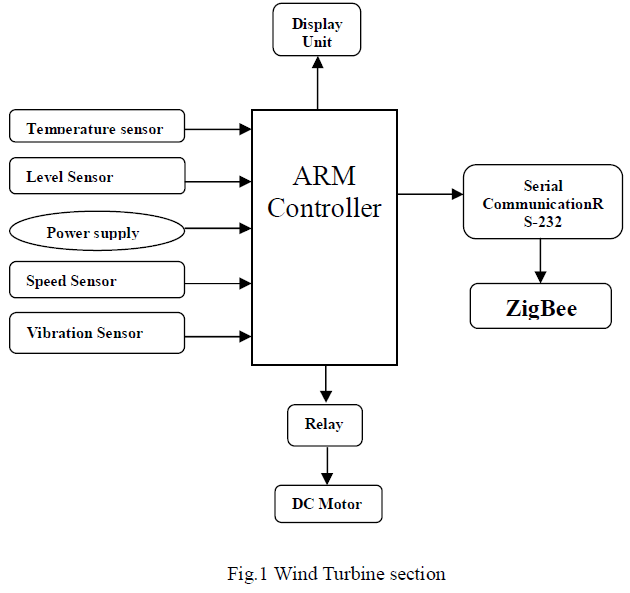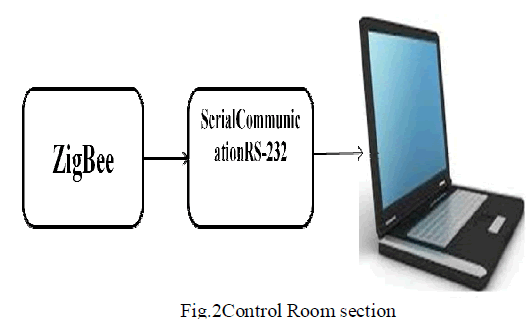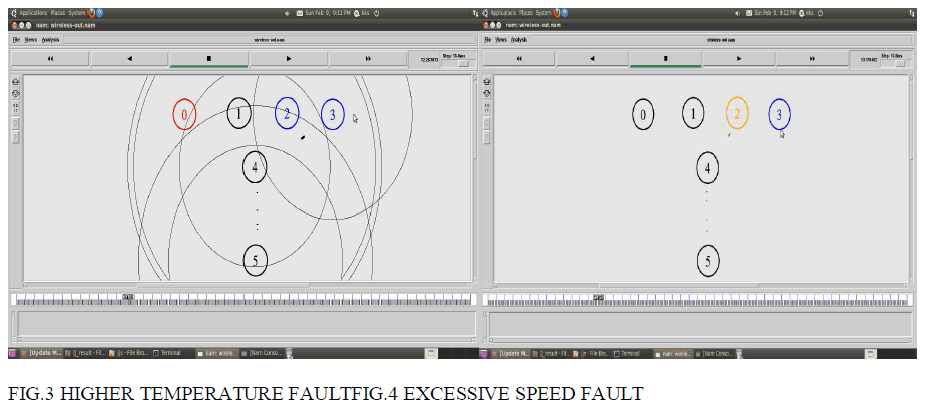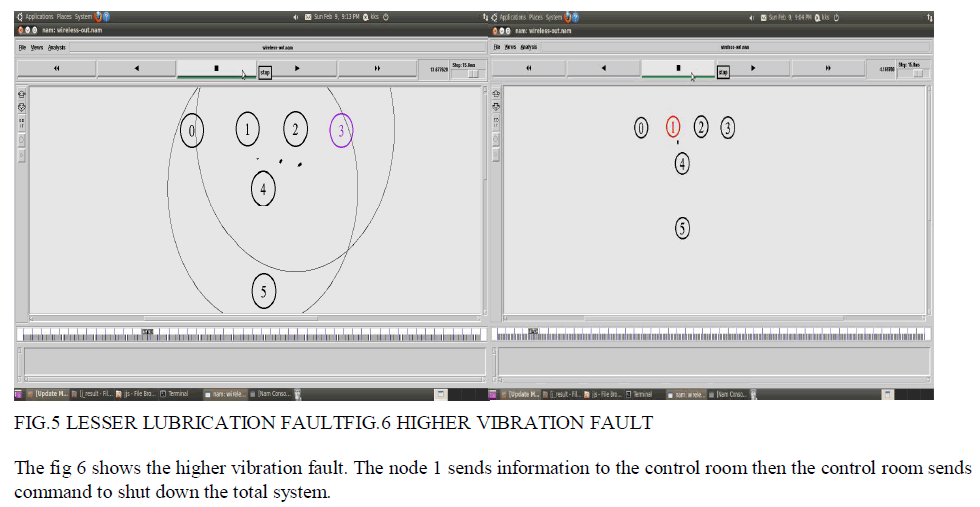ISSN ONLINE(2278-8875) PRINT (2320-3765)
ISSN ONLINE(2278-8875) PRINT (2320-3765)
Jaishree.S1, Dr.K.Sathiyasekar2, Sonika.S3
|
| Related article at Pubmed, Scholar Google |
Visit for more related articles at International Journal of Advanced Research in Electrical, Electronics and Instrumentation Engineering
The Wind Turbine blast is identified as a major problem against green energy. It is not only the threatening factor for the people but also causes dangerous hazard for human life. To overcome this problem and to increase the green energy, a simple system is introduced to monitor and prevent the fault occurrence in Small Wind Turbine. It collects all the parameters like temperature, vibration, oil level and speed from main components of the turbine and sends it to the control room via wireless ZigBee. At Control room through PC (Personal Computer) it is possible to view the current status of the Wind Turbine. In Case of fault occurrence indication from control room automatically command will send to wind turbine section to overcome the fault than the fault occurrences can be prevented.
Keywords |
| Wind Turbine, Fault Monitoring and Preventive System, ARM Controller, DC motor, ZigBee Wireless module |
INTRODUCTION |
| Wind energy is conversion of kinetic energy to mechanical energy to electrical energy. It is the known factor that global warming increasing day by day hence it is essential to increase the green energy. In earlier days the wind energy has been used for grinding flours, pumping water and for other purposes. Nowadays the wind energy is utilized very well for power generation since today it is not at all possible to think the world without power. Tamil Nadu is the number one wind power hub of South Asia generates 40% (7158MW) of India's wind power.Recent study is that nowadays the Wind Turbine blast happens commonly The cost of one wind turbine is nearly 1crore including its development and placement cost which leads to not only severe loss but also dangerous hazard to human life.This fault monitoring and preventive system collects the information like temperature, vibration, speed and oil level from Wind Turbine main components such as nacelle, gear box and shaft and send it to the control room via Wireless ZigBee hence it helps to avoid such dangerous hazards[1][3][7]. |
RELATED WORKS |
| The maintenance of offshore Wind Turbine and its failure rate is very high by using the wireless sensor networks for environment monitoring and key components cluster based distribution of wireless sensor network topology the failure ratescan be reduced [1].The necessity of monitoring and making automation of Wind Turbine with fault diagnosis system and the CAN Bus which is used as Interface module to communicate the monitored parameters between the Wind Turbine and the control centre with the help of RS-232 Serial Communication. Here GPRS is used to transfer the data from wind turbine section to control room [10].The importance renewable energy and its monitoring technologies of wind turbines facilitate the prevention of accidental and component or structure failure. The acquisition of data under different conditions can be time and cost consuming. Low-cost, low power wireless sensors have materialized as a window for these applications. Economical and flexible wireless sensors networks can be installed within a large structure to evaluate the response and performing monitoring algorithms. In this paper, wireless sensors are deployed into a wind turbine farm to monitor the structures to present models of wind turbine behaviour and response to loading and controlling the generator parameters by getting even to rewrite the control algorithm from the system[9].Methodology to manage the mechanical vibration and temperature from Small Wind Turbine (SWT) with a protection tool developed for preventive maintenance and to avoid catastrophic failure. The triple axis accelerometer used for vibration identification in SWT and thermocouple for temperature identification. These parameters values are monitored remotely through computer with the help of Wireless ZigBee [7]. |
INTRODUCTION TO ZIGBEE |
| ZigBee is a wireless communication used in Wind Turbine to send data to control room and to receive data from control room. It is based on a typical network architecture using an OSI model over an IEEE 802.15.4-2006. The ZigBee signals function like network signals and strictly similar to Bluetooth and Wi-Fi [4].ZigBee devices are meant for low power consumption these Devices put themselves to sleep when not in use, thereby conserving power. Hence this makes these devices ideal for battery-operated applications because they can last for a number of years before wanting fresh batteries. ZigBee is top in lucrative applications it scheme lends itself to detecting and monitoring applications and its practice in large scale wireless monitoring [4]. Hence it will be very much suitable for Wind turbine communication. |
WIND TURBINE SECTION |
| At Wind Turbine Section the System is developed to prevent Wind Turbine blasting hazards. The block diagram Fig1 explains the hardware components which are placed in the Wind Turbine. In this system the sensor sense the parameters valuesand send the data to the ARM Controller. The ARM is based on RISC architecture it simple design enables more efficient multi-core CPUs and higher core counts at lower cost, providing higher processing power and improved energy efficiency for servers and it reduces costs, heat and power usage [5] this makes data acquisition and processing from the sensor and send it to the Control room via wireless ZigBee. The temperature sensor senses the temperature and send the data to control room at control room through PC it is possible to view the current status of the Wind Turbine. The speed sensor senses the rotational speed from the Generator shaft; the level sensor senses the lubricant oil level from the Wind Turbine components [2] and vibration sensor sense the occurrence of higher vibration in any part of the Wind Turbine components. All this parameter data are send to the control room Section via wireless ZigBee. The display unit is placed is in the Wind Turbine section to show the parameters details which acts as the reference for operator in case of checking the working condition, are for any other revamping parts in the Turbine. |
 \ \ |
CONTROL ROOM SECTION |
| At control room section via PC it is possible to view the current status of the Wind Turbine. The receiver ZigBee receives the data from the Wind Turbine and it is connected to PC using Serial Communication RS232.Whenever the fault occurs in the Wind Turbine according to the type of fault the comment will be sent from the PC to Wind Turbine to overcome the fault and to prevent blasting hazard. |
 |
| In case of any fault occurrence like Temperature hike it is identified easily and immediately a comment will be sent from the control room to Wind turbine and the cooler will be switched on to reduce the temperature. Else if there is higher vibration immediately Turbine will be shut down and manual operation will be conducted to recover that fault. If the rotational speed is higher due to storm than immediately turbine speed will be reduced by applying electric breaks and system will be shut down to save the wind turbie blades from damages. For the case of lesser lubrication the auto lubrication process is implemented here. In this the DC motor will be switched on automatically which pumps the oil and fills the lubricant in appropriate parts of the Wind turbine. |
DC MOTOR FOR FAULT RECOVERY |
| DC motors role as the prime mover of the chemical injection pump. Electric motors are deliberated by industry professionals as more economical than engine-driven prime movers. They are less costly to install and maintain. In addition, electric motors pose no external costs relates to fuel or emissions compliance. Two types of DC motors commonly used for injection pump motors are DC permanent magnet and Brushless DC motors. Brushless DC motors are used in applications that require continuous duty, variable speed, and high torque response to maintain a constant pump speed even when pressure varies [6]. DC permanent magnet motors offer the advantages of low current/power consumption, high reliability and low maintenance with sealed bearings and heavy duty brushes [6]. Hence the DC permanent magnet motor will be very suitable for this purpose .The Turbine, gearbox and alternator has to be provided continuous lubrication. For this auto lubrication process at the time of lesser lubrication with the help of level sensor the intimation will be sent to the control room section hence from the control room the command will be sent to the DC motor which switch on and starts the motor and with pumping process the lubricant can be pumped and fills the oil in turbine parts. |
SIMULATION RESULT |
| The Wireless ZigBee connectivity’s data transfer is simulated using NS2 network simulator software by using AODV algorithm it ismodified from REAL network simulator.The fig 3 shows the temperature hike fault where the node 0 represent the higher temperature hence its sending information to control room i.e. node 4. From node 4 the command is sent to the node 5 to switch on the cooler. |
 |
| The fig 4 & 5 illustrates the fault of less lubrication and high speed. The fault indication will be sent to the control room and from the control room the command will be sent to the DC motor i.e. node 5. |
 |
CONCLUSION |
| The proposed system enables the monitoring and prevention of higher vibration, rise in temperature, higher speed as well as lesser lubrication of the Wind Turbine using the developed methodology to avoid blasting hazard. The software proposed a friendly graphical interface, assisting in making Decision to avoid catastrophic failures. Thus the ZigBee Wireless communication enables the remote controlling system of all these parameters from control room through PC. This is simple, convenient, time saving and high security system for Wind Turbine. |
References |
|